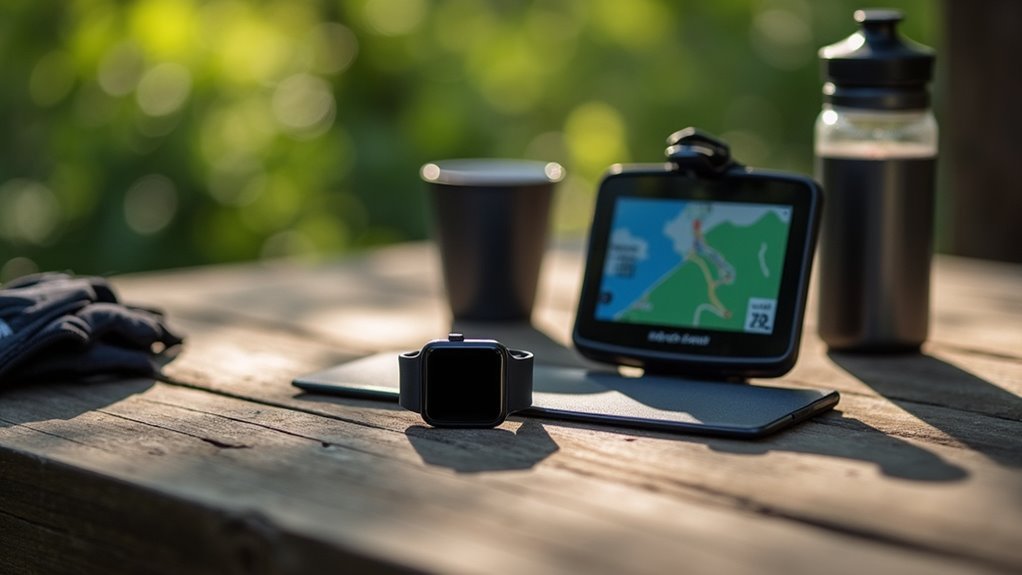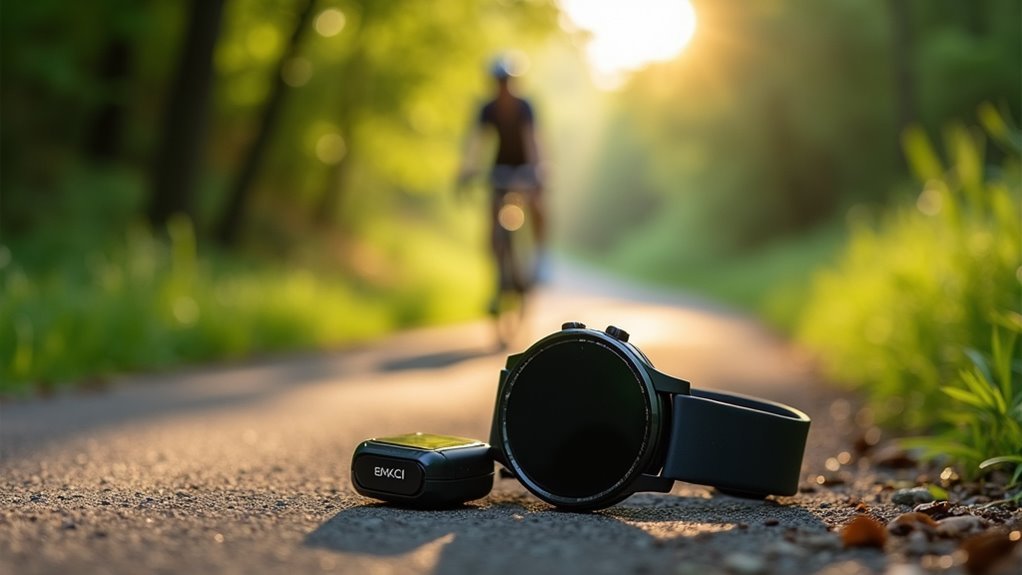Choose a cycling computer if you prioritize larger screens (320×240 pixels), longer battery life (12-45+ hours), and detailed cycling metrics like cadence and power data. Opt for a smartwatch if you want multi-sport tracking, daily health monitoring, and don’t mind smaller displays requiring arm movement to check. Consider your mounting preferences, navigation needs, and whether you value cycling-specific features over versatile daily use. These factors will guide your perfect choice.
Consider Your Screen Size and Mounting Requirements

Screen real estate makes a significant difference when you’re cycling at speed and need quick access to your data.
Bike computers typically offer larger displays with higher resolutions like 320 x 240 pixels, allowing you to view multiple data fields simultaneously without scrolling. They mount directly on your handlebars within your natural line of sight, reducing dangerous head movements and keeping your hands positioned safely.
Larger screens with superior resolution enable cyclists to monitor multiple metrics at once while maintaining safe handlebar grip and natural sight lines.
Smartwatches present challenges with their smaller screens, often requiring you to remove hands from handlebars to check metrics on your wrist.
You’ll find yourself limited to viewing single metrics effectively, and GPS navigation becomes more difficult on compact displays. Many dedicated cycling computers provide detailed mapping features that take advantage of their larger screen real estate.
Consider whether you prioritize extensive data visibility and safety through proper mounting, or prefer the lightweight comfort of wrist-worn devices for longer rides.
Evaluate Battery Life for Your Riding Duration
When you’re planning rides lasting several hours or multiple days, battery life becomes the deciding factor between cycling computers and smartwatches.
Cycling computers clearly outperform smartwatches, offering 12-45 hours compared to smartwatches’ 16-26 hours. Premium models like the Garmin Edge provide up to 100 hours in battery saver or solar mode, while the Coros Dura delivers nearly 100 hours with full features active.
For endurance cycling, choose devices with 24+ hours of battery life. Solar-enhanced computers add roughly two hours per hour of direct sunlight. Modern bike computers generally last a week on a single charge, making them ideal for multi-day touring adventures.
You can maximize runtime by activating battery saver mode, reducing screen brightness, turning off unnecessary sensors, and pre-loading routes.
Smartwatch users should consider portable chargers for longer adventures.
Assess Your Navigation and Mapping Needs

How often do you find yourself squinting at a tiny screen while trying to follow a complex route? Your navigation needs should heavily influence your device choice between a cycling computer and smartwatch.
Bike computers offer larger screens with detailed, full-color maps that you can view continuously without removing your hands from the handlebars. They excel at complex routes and provide real-time rerouting capabilities.
Smartwatches work well for simple, preloaded routes but require arm movement to check, which can be unsafe during rides. Smartwatches typically max out at around 1.2 inches, making constant visibility of data easier with a bike computer.
Consider these navigation factors:
- Screen visibility – Larger bike computer displays show more route information at once
- Safety – Handlebar-mounted computers allow safer glances than wrist-checking
- Route complexity – Multi-turn directions are clearer on bigger screens
- Trip length – Long-distance rides benefit from extensive map access
Compare Cycling-Specific Data and Multi-Sport Features
Beyond finding your way, the data capabilities of each device type reveal stark differences in how they serve cyclists versus multi-sport athletes. Cycling computers excel at real-time cycling metrics like cadence, power, and speed with larger, constantly visible displays. You’ll get more detailed training data and easier glanceability during rides.
Smartwatches shine in versatility, tracking multiple sports while monitoring your overall health metrics like sleep and daily activity. They’re perfect if you’re a triathlete or cross-trainer who needs thorough fitness tracking. However, their multi-functionality may limit cycling-specific insights and accuracy compared to dedicated cycling devices.
| Feature | Cycling Computer | Smartwatch |
|---|---|---|
| Cycling Data | Advanced power/cadence support | Basic cycling metrics |
| Multi-Sport | Cycling-focused only | Running, swimming, triathlon |
| Display | Large, always-visible | Smaller, wrist-based |
| Health Tracking | Limited to cycling | Thorough wellness |
Weigh Cost Against Versatility and Daily Use

While high-end cycling computers and premium smartwatches reach similar price points around £630, the value equation shifts dramatically when you consider daily utility.
Your smartwatch becomes a multi-device replacement, handling sleep tracking, recovery monitoring, and general fitness metrics beyond cycling. You’ll eliminate mounting costs and compatibility issues with non-standard handlebars while gaining seamless functionality across all activities.
A smartwatch delivers comprehensive health tracking and universal compatibility, replacing multiple specialized devices while providing seamless cross-activity functionality.
Consider these key factors when weighing your investment:
- Multi-functionality – Smartwatches replace multiple devices, offering better overall value
- Hidden costs – Cycling computers often require additional mounts and accessories
- Daily integration – You’ll use a smartwatch continuously versus cycling-specific occasions
- Device switching – Avoid juggling multiple gadgets for different activities
Smartwatches also deliver superior data collection capabilities, monitoring everything from blood oxygen levels to breathing patterns throughout your day. Your choice ultimately depends on whether you prioritize cycling specialization or extensive daily functionality.
Frequently Asked Questions
Can I Use Both a Cycling Computer and Smartwatch Together?
You can definitely use both devices together. They’ll complement each other perfectly – your cycling computer handles detailed navigation and data analysis while your smartwatch tracks fitness and manages phone notifications seamlessly.
Which Device Is Better for Group Rides and Sharing Data?
You’ll find bike computers better for group rides since they display detailed navigation and real-time data more clearly. However, you’ll get superior data sharing with smartwatches through seamless app integration and social platforms.
How Do Weather Conditions Affect Device Performance and Durability?
Weather affects your device’s GPS accuracy, display visibility, and battery life. You’ll find cycling computers generally offer better shock absorption and weather sealing, while both device types handle temperature extremes well with proper maintenance.
What Happens if My Cycling Computer or Smartwatch Breaks Mid-Ride?
You’ll need to safely pull over and assess the damage. Switch to your backup device, attempt quick troubleshooting, record manual notes, and notify contacts about the issue for safety.
Are There Subscription Fees for Maps or Premium Features?
You’ll find basic maps and navigation are typically free with most devices. However, you might pay $5-10 monthly for premium features like advanced analytics, coaching plans, or specialized topographic maps.
In Summary
You’ll make the best choice by honestly evaluating your priorities. If you’re serious about cycling performance and need detailed metrics, you’ll benefit from a dedicated cycling computer. However, if you want one device that tracks everything from daily steps to weekend rides, a smartwatch offers better value. Don’t overthink it—choose what matches your actual riding habits and budget, not aspirational goals.





Leave a Reply